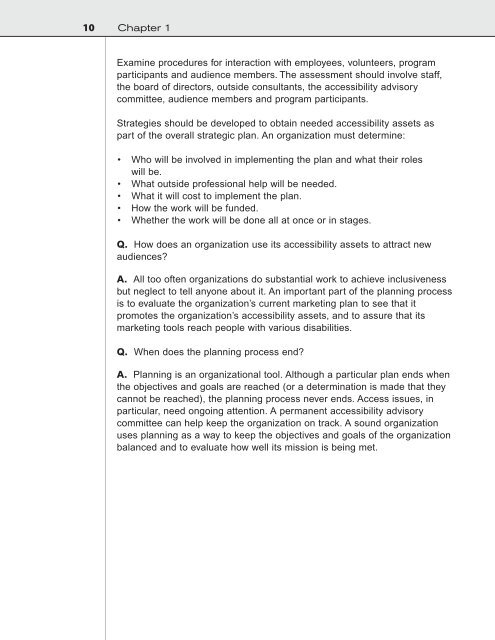Design for Accessibility: A Cultural Administrator's Handbook
Design for Accessibility: A Cultural Administrator's Handbook
Design for Accessibility: A Cultural Administrator's Handbook
You also want an ePaper? Increase the reach of your titles
YUMPU automatically turns print PDFs into web optimized ePapers that Google loves.
10 Chapter 1<br />
Examine procedures <strong>for</strong> interaction with employees, volunteers, program<br />
participants and audience members. The assessment should involve staff,<br />
the board of directors, outside consultants, the accessibility advisory<br />
committee, audience members and program participants.<br />
Strategies should be developed to obtain needed accessibility assets as<br />
part of the overall strategic plan. An organization must determine:<br />
• Who will be involved in implementing the plan and what their roles<br />
will be.<br />
• What outside professional help will be needed.<br />
• What it will cost to implement the plan.<br />
• How the work will be funded.<br />
• Whether the work will be done all at once or in stages.<br />
Q. How does an organization use its accessibility assets to attract new<br />
audiences?<br />
A. All too often organizations do substantial work to achieve inclusiveness<br />
but neglect to tell anyone about it. An important part of the planning process<br />
is to evaluate the organization’s current marketing plan to see that it<br />
promotes the organization’s accessibility assets, and to assure that its<br />
marketing tools reach people with various disabilities.<br />
Q. When does the planning process end?<br />
A. Planning is an organizational tool. Although a particular plan ends when<br />
the objectives and goals are reached (or a determination is made that they<br />
cannot be reached), the planning process never ends. Access issues, in<br />
particular, need ongoing attention. A permanent accessibility advisory<br />
committee can help keep the organization on track. A sound organization<br />
uses planning as a way to keep the objectives and goals of the organization<br />
balanced and to evaluate how well its mission is being met.


